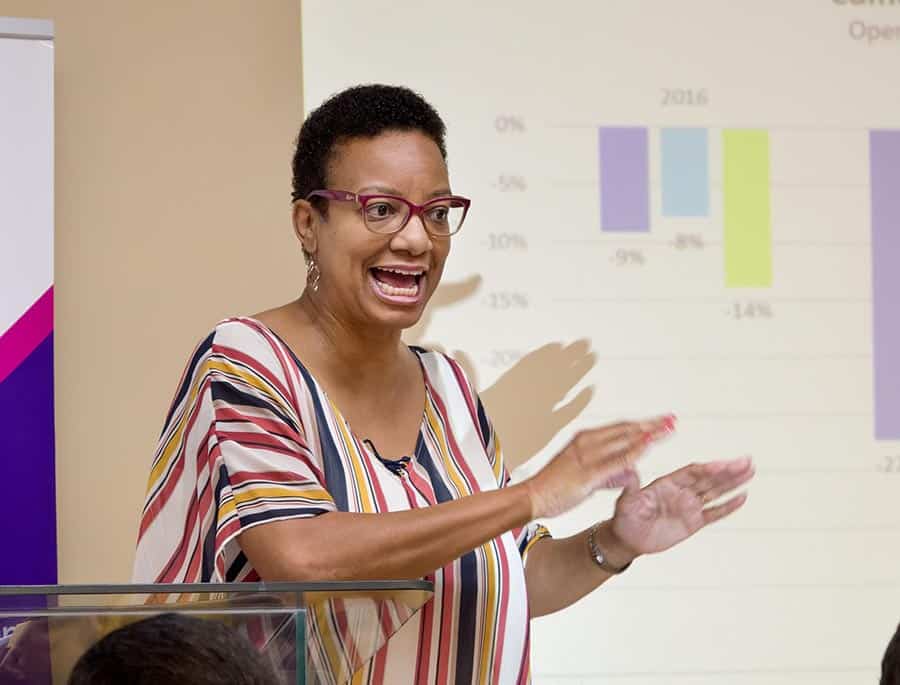
Above: Allison Demas presents her findings on advertising spending in the media. Photo by Mark Lyndersay.
BitDepth#1235 for February 06, 2020
On Tuesday, Media InSite, the media monitoring company created by Allison Demas in 2011, presented its findings on advertising in media over the last five years.
The news was generally bleak. It also failed completely to surprise an audience comprised almost entirely of representatives of major clients, advertising agencies and advertising sales executives from media houses.
Registering the steepest decline was advertising for newspapers, which dropped 33 per cent in newspaper display space.
According to Demas, newspaper advertising for mobile phones and new car sales tanked by 72 per cent and 68 per cent respectively, though adult drinks ads are up 72 per cent.
Radio and television failed to break the flatline of zero growth in any significant way over the years under review.
Television achieved a 2.43 per cent growth in paid advertising for 2018 and radio hit 3.53 per cent in 2019.
And it isn’t just volumes that are diminishing. Entire brands are disappearing from paid advertising for local media.
On television, 16 per cent of brands using the medium disappeared between 2015 and 2019.
Allison Demas, CEO, Media InSite
“Are these brands switching to digital?Have they gone out of business?”
For radio, there was a five per cent drop in paid ad spots across the 29 radio stations that Media Insite monitors, with 139 brands absenting themselves from advertising using that medium.
“Are these brands switching to digital?” asked Demas.
“Have they gone out of business?”
In radio, one key shift in emphasis was identified, a turn to announcer-read advertisements and sponsorship links, which Media Inside does not monitor.
Showing strong performance in the acquisition of produced advertising were 107.7 FM and Radio Taj 92.3FM. Compared to its showing in 2015, 95.1 FM dropped 55 per cent of its ad haul in 2019.
The big spenders in advertising were KFC, FCB, Republic, bmobile and Courts, but Media InSite found that their advertising spread tracked closely with overall spending across the industry, with a variance of between zero and four per cent.
Of that top five, only KFC and FCB consistently and incrementally increased their advertising spending.
Courts dropped roughly $12 million in spending from its budget by 2019 from a peak of $25 million in 2016.
The top five’s advertising investment dropped between 2015 and 2020 by tens of millions of dollars and that’s created a major problem in covering costs for information gathering for the media and advertising business.
Since the MediaTrak surveys stopped in 2015, there has been no public unveiling of any metrics for the media industry and the advertising that supports it until Tuesday’s announcements. The MFO surveys ended in 2010.
These surveys cost serious money and a fractured, rambunctious media landscape can’t seem to get it together to fund a study of the finances and audience traction for the industry as a sector.
The resistance is significant.
“Everytime that we have tried to do that – and we have tried three times – we have been burnt,” said Demas.
Astonishingly, online performance, which offers the most readily available metrics, is not being reliably and independently tracked at all.
Joe Taylor, the Miami-based media monitoring consultant for Media InSite, explained via video conference that “What we really need is more participation and cooperation from media houses to be able to analyse and track that kind of information.”
Without that engagement, the monitoring company is limited to a top-level general view of online advertising, with no insight into the budget for the click-based spending that fuels , much of it.
“Clients are losing confidence in what they are buying into, particularly in the economic climate they are investing in.”
Anthony Inglefield, President, AAATT
“We want to do media research is to ensure that there is value for the media spend,” said Anthony Inglefield, president of the Advertising Agencies Association of TT.
“Clients are losing confidence in what they are buying into, particularly in the economic climate they are investing in.”
“Brands are spending less, we need to be able to validate the spend for clients.”
“Let’s not shy away from the fact that there is a contraction in the economy and there is shrinking in client spending,” said Ken Attale, CEO of Lonsdale Saatchi & Saatchi.
“The client sees the spending as a cost, and they put advertising first on the chopping block.”
On digital spending and its ready metrics, CMB’s Mark White explained that: “They may get likes, but they are getting numbers and they aren’t getting comparative numbers from local media.”
“Product development, evolution and adaptation depends on knowing the numbers that are reflected in advertising performance and audience preference.”
Derek Waddell, Media InSite’s Business Development Consultant, offered the perspective of a client.
“My focus with clients is to ensure that there is a better connection between what they are spending and the results they are getting from it.”
“Too many people are afraid to experiment. As a group, we are too lazy right now to do the work to close the ROI (Return on Investment) loop to analyse and provide proof of value for the spend.”


